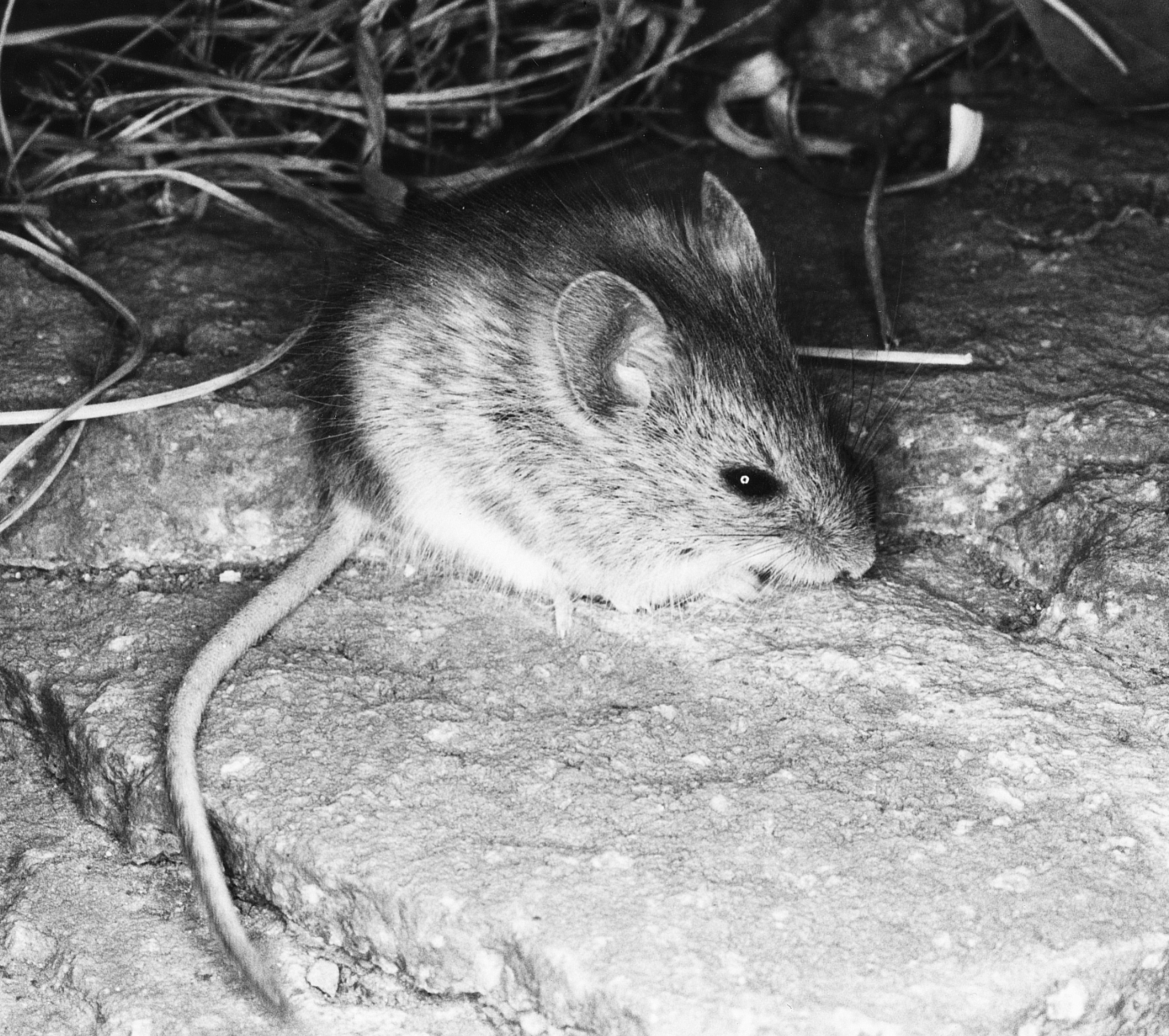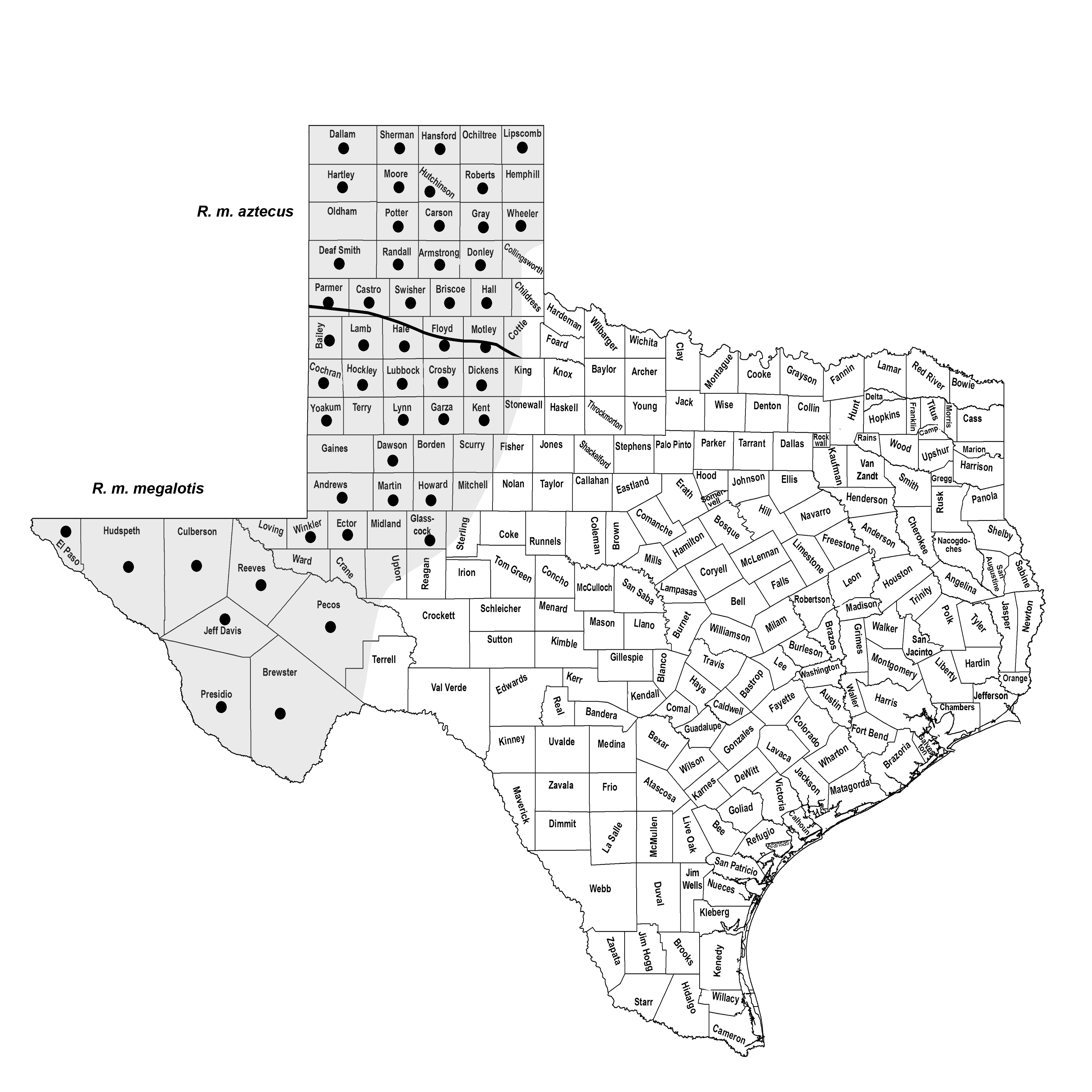WESTERN HARVEST MOUSE
Reithrodontomys megalotis (Baird 1858)
Order Rodentia : Family Cricetidae
DESCRIPTION. A medium-sized harvest mouse; tail about as long as head and body; the dark dorsal and light ventral stripes about equal in width; ears pale flesh color (or buffy cinnamon); upperparts brownish buff, darkest in middle of back; underparts whitish. Differs from R. fulvescens in shorter tail, pale rather than blackish ears basally; from R. montanus in larger size and lack of dark color at base of ears. Dental formula: I 1/1, C 0/0, Pm 0/0, M 3/3 × 2 = 16. Averages for external measurements: total length, 140 mm; tail, 71 mm; hind foot, 18 mm. Weight, 10–16 g.

DISTRIBUTION. Western Texas, from the Panhandle, High Plains, and Rolling Plains southward to Trans-Pecos, and barely reaching the northwestern portion of the Edwards Plateau.

SUBSPECIES. Reithrodontomys m. aztecus in the northern part of the range and R. m. megalotis to the south.
Habits. These harvest mice favor grassy and weedy habitats such as lightly grazed pastures, meadows, fencerows, fallow fields, and edge habitats between agricultural and riparian areas. Meadows, marshes, and weed-covered banks of irrigation ditches seem to offer optimum habitat conditions. The species seldom is found in forested areas. In the Big Bend area, it has been taken in grasslands, riparian, and desert scrub situations. On the Llano Estacado it prefers grassy, weedy, brushy fencerows and highway right-of-ways.
They utilize the runways and underground burrows of other rodents and frequently take over vacated burrows of pocket gophers. The nest usually is placed on the ground or slightly above it under some protective cover such as a board, a clump of lodged grass, or a tangle of weeds. It is a globular structure, about 7 cm in diameter, composed of plant fibers, and usually has only one opening. These mice also are known to use the nests of marsh wrens in cattail marshes. They appear to be strictly nocturnal and active throughout the year. They are almost entirely vegetarians and feed on the green parts and seeds of plants.
In Texas the breeding season extends through most of the year, with a possible reduction in reproductive activity in midsummer months. On the Llano Estacado, pregnant females have been taken in all months except January, February, and June. Several litters a season seem to be the rule. A captive female produced seven litters, totaling 17 young, in 1 year. Litter size, based on 24 embryo counts, ranged from one to seven and averaged about four. The gestation period is about 23 days. At birth, the young mice are blind, naked, and helpless and weigh 1–1.5 g. By the end of the first week they are covered with pigmented hair dorsally; by the 11th or 12th day the eyes open, at which time the mice begin to eat solid food. They are weaned by the 19th day. Sexual maturity is reached in about 4 months.
These mice seldom are of economic importance. They are utilized as a food source by many predators, including weasels, foxes, owls, and snakes.
POPULATION STATUS. Uncommon. Similar to the eastern harvest mouse (R. humulis), R. megalotis are rarely encountered. These mice prefer grassy or weedy areas and can be collected in roadside ditches and fence lines.
CONSERVATION STATUS. The IUCN lists the western harvest mouse as a species of least concern, and it does not appear on the federal or state lists of concerned species. They appear to be in good shape over most of their range, although they are seldom captured in large numbers by mammalogists.
REMARKS. In 1997, Frank Yancey and Clyde Jones at Texas Tech University found that R. megalotis and R. fulvescens have dispersed back and forth between the High Plains and the Rolling Plains by making extensive use of the grassy habitats associated with a rail trail created when TPWD converted about 100 km (62 mi.) of former railway into a hiking and horseback trail. This example of using fabricated dispersal routes may be representative of the way other small mammals have dispersed across different vegetative regions during this century.
Reithrodontomys megalotis is sometimes confused with R. montanus if adults are not compared. In addition to characters listed in the key, the former has a longer tail with a wider, usually less distinct, middorsal stripe, and the breadth of its braincase usually is >9.8 mm; the braincase width of R. montanus is <9.5 mm.
From The Mammals of Texas, Seventh Edition by David J. Schmidly and Robert D. Bradley, copyright © 1994, 2004, 2016. Courtesy of the University of Texas Press.
Natural Science Research Laboratory
-
Address
Museum of Texas Tech University, 3301 4th street, Lubbock, TX 79409 -
Phone
806.742.2486 -
Email
nsrl.museum@ttu.edu

